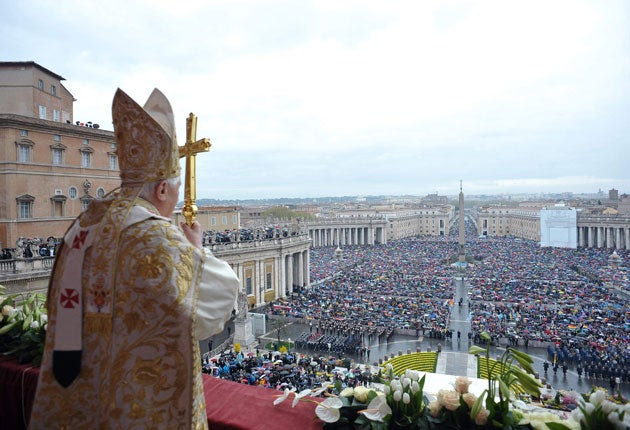Vatican lifts veil of secrecy on abuse cases
As two more cover-ups are revealed, a simple online guide to the canonical procedures for dealing with accused priests is launched

The Congregation for the Doctrine of the Faith – the office once known as the Inquisition – has long epitomised the secrecy of the Vatican, with responsibility for banning books and meting out punishments as severe as excommunication and burning at the stake. Now, as the office's handling of child-molesting priests comes increasingly under fire, the Vatican is starting to open up. Tomorrow, it will release online a concise guide for the layman on how the congregation handles sex abuse allegations.
This follows the Vatican's announcement that Pope Benedict XVI would meet with more abuse victims, and that transparency in dealing with abuse allegations is an "urgent requirement" for the church – a sharp turnabout in Rome's previously defensive response to the scandal.
The softening of the previously haughty line comes as two new cases emerged. A letter written by a now-dead Canadian bishop shows church officials knew of sexual abuse allegations involving a priest before his promotion to a top Vatican post and then discussed with Vatican officials how to keep the scandal from becoming public. And a Catholic priest who was defrocked after a nun accused him of raping three children in Bolivia has been living with his family in Uruguay for more than a year – with the full knowledge of Uruguayan church officials – despite an Interpol warrant for his arrest.
The new layman's guide, a copy of which was obtained by Associated Press, doesn't contain any information that isn't available to the public through a trip to a specialised religious library or a Vatican bookshop. But it puts various sources of complicated canonical procedures together in a concise, easy-to-read, one-page guide, without cumbersome canon law citations and Latin phrases.
The church's internal justice system for dealing with abuse allegations has come under attack because of claims by victims that their accusations were long ignored by bishops, more concerned about protecting the church, and by the congregation, which was headed by Cardinal Joseph Ratzinger from 1981 until he was elected Pope in 2005. Jose Barba Martin of Mexico tried for years to have his accusations against the founder of the Legionaries of Christ heard by the congregation. In the end, it took eight years for Rome to discipline the Rev Marcial Maciel, and require him to live a life of reserved prayer. Maciel died in 2008 before the Legionaries admitted he had fathered at least one child and molested young seminarians.
According to Vatican norms, issued in 2001 and summarised in the new guide, a bishop must investigate every allegation of sexual abuse of a minor by a cleric. If the accusation has a semblance of truth, the case is referred to the congregation, which decides how to proceed. The congregation's disciplinary department, which weighs each case, is composed of 10 people: Monsignor Charles Scicluna, who is the promoter of justice or chief prosecutor; the bureau chief; seven priests; and a lay lawyer, though other officials from other Vatican offices are brought in for specific cases.
They can decide to authorise the diocese to pursue either a judicial or an administrative trial, both of which can condemn a priest to a number of penalties, including defrocking, or what the church calls being reduced to the lay state. Victims can also seek damages. Or the congregation can conduct a trial on its own, although that is rare. If the evidence is overwhelming, the congregation can refer the case directly to the Pope, who can issue a decree dismissing the priest from the priesthood altogether.
Scicluna has said that since 2001, some 3,000 cases concerning accusations of abuse dating back 50 years have been referred to the congregation. A full canonical trial has taken place in 20 per cent of the cases; 60 per cent of the time there has been no trial, primarily because the priest was old and was instead disciplined by other means, such as restricting where he could celebrate Mass and sending him to pray. In 10 per cent of the cases, the Pope has dismissed the priest from the priesthood. In the remaining 10 per cent of the cases, the priest himself has asked to be laicised.
The Rev Thomas Doyle, a canon lawyer who has been the main expert witness for victims in hundreds of lawsuits against priests and dioceses in the US and elsewhere, said canonical trials can be an effective way to mete out justice – if they are held. The problem is that they have rarely been held, said Mr Doyle, who in the course of testifying in lawsuits has reviewed documentation from 190 of the 195 Catholic dioceses in the US and reviewed more than 1,500 priests' personnel files.
"Almost all the cases – where bishops received allegations that a priest sexually abused, raped or molested a child – the bishops' procedure was simply to confront the priest, transfer him to another assignment, and in a few cases they send them to counselling centres," he said.
Mr Doyle said the secrecy surrounding the proceedings is excessive in requiring the victims to take an oath of secrecy once the trial begins. "The justification for secrecy is usually given to protect the reputations of everyone involved – which is legitimate – and the need to conduct the trial as unencumbered by outside influences," he said. "But the common law system is evidence you can have some transparency."
The congregation today is housed in a grand palazzo on St Peter's Square, outside which two Swiss Guards stand at attention.
Join our commenting forum
Join thought-provoking conversations, follow other Independent readers and see their replies
Comments